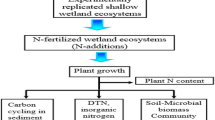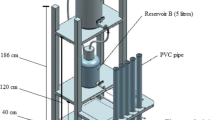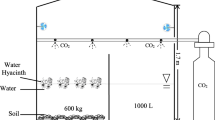Abstract
Soil respiration is a main dynamic process of carbon cycle in wetland. It is important to contribute to global climate changes. Water table and nutritious availability are significant impact factors to influence responses of CO2 emission from wetland soil to climate changes. Twenty-four wetland soil monoliths at 4 water-table positions and in 3 nitrogen status have been incubated to measure rates of CO2 emission from wetland soils in this study. Three static water-table controls and a fluctuant water-table control, with 3 nitrogen additions in every water-table control, were carried out. In no nitrogen addition treatment, high CO2 emissions were found at a static low water table (I) and a fluctuant water table (IV), averaging 306.7mg/(m2·h) and 307.89mg/(m2·h), respectively, which were 51%–57% higher than that at static high water table (II and III). After nitrogen addition, however, highest CO2 emission was found at II and lowest emission at III. The results suggested that nutritious availability of wetland soil might be important to influence the effect of water table on the CO2 emission from the wetland soil. Nitrogen addition led to enhancing CO2 emissions from wetland soil, while the highest emission was found in 1N treatments other than in 2N treatments. In 3 nutritious treatments, low CO2 emissions at high water tables and high CO2 emissions at low water tables were also observed when water table fluctuated. Our results suggested that both water table changes and nutritious imports would effect the CO2 emission from wetland.
Similar content being viewed by others
References
AERTS R, LUDWIG F, 1997. Water-table changes and nutritional status affect trace gas emissions from laboratory columns of peatland soils [J]. Soil Biology & Biochemistry, 29(11–12): 1691–1698.
BLODAU C, 2002. Carbon cycling in peatlands—a review of processes and controls [J]. Environmental Revelation, 10: 111–134.
BLODAU C, BASILIKO N, MOORE T R, 2004. Carbon turnover in peatland mesocosms exposed to different water table levels [J]. Biogeochemistry, 67(3): 331–351.
BLODAU C, MOORE T R, 2003a. Experimental response of peatland carbon dynamics to a water table fluctuation [J]. Aquatic Sciences, 1: 47–62.
BLODAU C, MOORE T R, 2003b. Micro-scale CO2 and CH4 dynamics in a peat soil during a water fluctuation and sulfate pulse [J]. Soil Biology & Biochemistry, 35(4): 535–547.
BLOOM A J, SUKRAPANNA S S, WARNER R L, 1992. Root respiration associated with ammonium and nitrate absorption and assimilation by barley [J]. Plant Physiology, 99: 1294–1301.
BOWDEN R D, DAVIDSGN E, SAVAGE K et al., 2004. Chronic nitrogen additions reduce total soil respiration and microbial respiration in temperature forest soils at the Harvard Forest [J]. Forest Ecology and Management, 196(1): 43–56.
BRIDGHAM S D, RICHARDSON C J, 1992. Mechanisms controlling soil respiration (CO2 and CH4) in southern peatlands [J]. Soil Biology & Biochemistry, 24(11): 1089–1099.
BRIDGHAM S D, JOHNSTON C A, PASTOR P et al., 1995. Potential feedbacks of northern wetlands on climate change [J]. BioScience, 45: 262–274.
CHIMNER R A, 2004. Soil respiration rates of tropical peatlands in Micronesia and Hawaii [J]. Wetlands, 24(1): 51–56.
CHIMNER R A, COOPER D J, 2003. Influence of water table levels on CO2 emissions in a Colorado subalpine fen: an in situ microcosm study[J]. Soil Biology & Biochemistry, 35(3): 345–351.
CHRISTENSEN T R, JONASSON S, CALLAGHAM T V et al., 1999. On the potential CO2 release from tundra soils in a changing climate [J]. Applied Soil Ecology, 11(2–3): 127–134.
CLEIN J S, SCHIMEL J P, 1994. Reduction in microbial activity in birch litter due to drying and rewetting events [J]. Soil Biology & Biochemistry, 26(3): 403–406.
CLYMO R S, 1983. Mires: swamp, bog, fen and moor—generall studies[A]. In: GORE A J P (ed.). Ecosystems of the World [C]. Amsterdam: Elsevier, 159–224.
FRANCEZ A J, VASANDER H, 1995. Peat accumulation and peat decomposition after human disturbance in French and Finnish mires [J]. Acta Oecolgica, 16: 599–608.
FREY S D, KNORR M, PARRENT J L et al., 2004. Chronic nitrogen enrichment affects the structure and function of the soil microbial community in temperate hardwood and pine forests [J]. Forest Ecology and Management, 196(1): 159–171.
FUNK D W, PULLMAN E R, PERTSON K M et al., 1994. Influence of water table in carbon dioxide, carbon monoxide, and methane fluxes from taiga bog microcosms [J]. Global Biogeochemical Cycles, 8(3): 271–278.
HOGG E H, 1993. Decay potential of hummock and hollow Sphagnum peats at different depths in a Swedish raised bog [J]. Oikos, 66: 269–278.
HOUGHTON J T, CALLANDER B A, VARNEY S K, 1992. The Supplementary Report to the IPCC Scientific Assessment, Intergovernmental Panel on Climate Change [M]. Bracknell: Meteorological Office.
KELLER J K, SCOTT D B, CARMEN T et al., 2005. Limited effects of six years of fertilization on carbon mineralization dynamics in a Minnesota fen [J]. Soil Biology & Biochemistry, 37(6): 1–8.
KIM J, VERMA S B, 1992. Soil surface CO2 flux in a Minnesota peatland [J]. Biogeochemistry, 18: 37–51.
LI Ying, ZHANG Yang-zhen, ZHANG Shu-wen, 2002. The landscape pattern and ecologic effect of the marsh changes in Sanjiang Plain [J]. Scientia Geographica Sinica, 22(6): 677–682. (in Chinese)
LIEFFERS V J, 1988. Sphagnum and cellulose decomposition in drained and natural areas of an Alberta peatland [J]. Canadian Journal of Soil Science, 68: 755–761.
MOORE T R, 1994. Trace gas emissions from Canadian peatlands and the effect of climatic change [J]. Wetlands, 14(3): 223–228.
MOORE T R, DALVA M, 1993a. The influence of temperature and column of peatland soils [J]. Journal of Soil Science, 44: 651–664.
MOORE T R, DALVA M, 1993b. The influence of temperature and water position on carbon dioxide and methane emissions from laboratory column of peatland soils [J]. Journal of Soil Science, 44: 651–664.
MOORE T R, DALVA M, 1997. Methane and carbon dioxide exchange potentials of peat soils in aerobic and anaerobic laboratory incubations [J]. Soil Biology & Biochemistry, 29(8): 1157–1164.
PANGLE R E, SEILER J, 2002. Influence of seedling roots, environmental factors and soil characteristics on soil CO2 efflux rates in a 2-year-old loblolly pine (Pinus taeda L.) plantation in the Virginia Piedmont[J]. Environmental Pollution, 116(1): 85–96.
SAMUELSON L J, KURT J, TOM S, et al., 2004. Intensive management modifies soil CO2 efflux in 6-year-old Pinus teada L. stands [J]. Forest Ecology and Management, 200(1–3): 335–345.
SCHLESINGER W H, ANDREWS J A, 2000. Soil respiration and the global carbon cycle [J]. Biogeochemistry, 48: 7–20.
SILVOLA J, ALM J, AHLHOLM U, 1992. The effect of plant roots on CO2 release from peat soil [J]. Suo, 43: 259–262.
SONG Chang-chun, WANG Yi-yong, WANG Yue-shi et al., 2003a. Carbon dynamics of wetland in the Sanjiang Plain[J]. Chinese Geographical Science, 13(3): 228–231.
SONG Chang-chu, YAN Bai-xing, WANG Yue-si et al., 2003b. Characteristics and impacting factors of CH4 and CO2 fluxes in Sanjiang Plain Wetlands [J]. Chinese Science Bulletin, 48(23): 2473–2477. (in Chinese)
SONG Chang-chun, YANG Wen-yan, XU Xiao-feng et al., 2004. Dynamics of CO2 and CH4 concentration in the mire soil and its impact factors [J]. Environmental Science, 25(4): 1–6. (in Chinese)
WADDINGTON J M, ROULET N T, 2000. Carbon balance of a boreal patterned peatland [J]. Global Change Biology, 6(1): 87–97.
WANG Shao-qiang, LIU Ji-yuan, 2002. Research status of impact factors of soil carbon storage [J]. Advance in Earth Sciences, 17(4): 528–533. (in Chinese)
Author information
Authors and Affiliations
Additional information
Foundation item: Under the auspices of the National Natural Science Foundation of China (No. 90211003) and the Knowledge Innovation Program of Chinese Academy of Sciences (No. KACX3-SW-332)
Biography: YANG Ji-song (1978-), male, a native of Chengwu of Shandong Province, Ph.D. candidate, specialized in environmental ecology and wetland biogeochemistry. E-mail: yangjisong@neigae.ac.cn
Rights and permissions
About this article
Cite this article
Yang, Js., Liu, Js., Yu, Jb. et al. Effects of water table and nitrogen addition on CO2 emission from wetland soil. Chin. Geograph.Sc. 15, 262–268 (2005). https://doi.org/10.1007/s11769-005-0039-1
Received:
Issue Date:
DOI: https://doi.org/10.1007/s11769-005-0039-1




